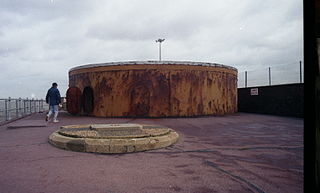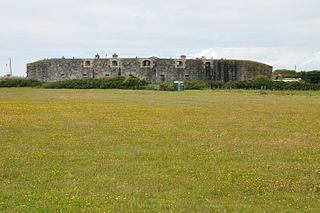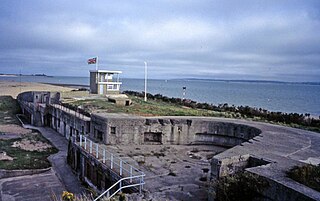
Cawsand and Kingsand are twin villages in southeast Cornwall, England, United Kingdom. The village is situated on the Rame Peninsula and is in the parish of Maker-with-Rame.

The Admiralty Pier Turret, or Dover Turret, is an enclosed armoured turret built in 1882 on the western breakwater of Dover Harbour in southeast England. It contains two Fraser RML 16 inch 80 ton guns, the biggest installed in the United Kingdom. Declared obsolete in 1902, it is currently part of the port and inaccessible, though the guns remain in place.

New Tavern Fort is an historic artillery fort in Gravesend, Kent. Dating mostly from the 18th and 19th centuries, it is an unusually well-preserved example of an 18th-century fortification and remained in use for defensive purposes until the Second World War. It was built during the American War of Independence to guard the Thames against French and Spanish raiders operating in support of the newly formed United States of America. It was redesigned and rebuilt in the mid-19th century to defend against a new generation of iron-clad French warships.

Fort Gilkicker is a historic Palmerston fort built at the eastern end of Stokes Bay, Gosport, Hampshire England to dominate the key anchorage of Spithead. It was erected between 1863 and 1871 as a semi-circular arc with 22 casemates, to be armed with five twelve-inch guns, seventeen ten-inch guns and five nine-inch guns. The actual installed armament rather differed from this. In 1902 the RML guns were replaced by two 9.2-inch and two six-inch BL guns, and before the First World War the walls were further strengthened with substantial earthwork embankments. The fort was disarmed in 1956 and used for storage until 1999, and is currently in a state of disrepair.

Coastal artillery is the branch of the armed forces concerned with operating anti-ship artillery or fixed gun batteries in coastal fortifications.

Whitsand Bay, situated in south east Cornwall, England, runs from Rame Head in the east to Portwrinkle in the west. It is characterised by sheer, high cliffs, dramatic scenery and long stretches of sandy beaches. The South West Coast Path runs the length of the bay.

Fort Rodd Hill National Historic Site is a 19th-century coastal artillery fort on the Colwood side of Esquimalt Harbour,. The site is adjacent to Fisgard Lighthouse National Historic Site, the first lighthouse on the west coast of Canada. Both the fort and lighthouse are managed and presented to the public by Parks Canada.

A disappearing gun, a gun mounted on a disappearing carriage, is an obsolete type of artillery which enabled a gun to hide from direct fire and observation. The overwhelming majority of carriage designs enabled the gun to rotate backwards and down behind a parapet, or into a pit protected by a wall, after it was fired; a small number were simply barbette mounts on a retractable platform. Either way, retraction lowered the gun from view and direct fire by the enemy while it was being reloaded. It also made reloading easier, since it lowered the breech to a level just above the loading platform, and shells could be rolled right up to the open breech for loading and ramming. Other benefits over non-disappearing types were a higher rate of repetitive fire and less fatigue for the gun crew.

Tregantle Fort in south east Cornwall is one of several forts surrounding Plymouth that were built as a result of a decision in Lord Palmerston's premiership to deter the French from attacking naval bases on the Channel coast.

Fort Pasir Panjang or Labrador Battery is located within Labrador Park at the southern tip of Singapore island. It was one of the 11 coastal artillery forts built by the British in the 19th century to defend the western passageway into Keppel Harbour against piracy and foreign naval powers. During the 1942 Battle of Pasir Panjang, the fort played a supporting role but a limited one in defending the Malay Regiments against the Japanese invasion at Bukit Chandu. In 1995, the site was gazetted by the National Heritage Board as one of the 11 World War II sites in Singapore.

The Steele Point Battery is a small fort, on the shores of Sydney Harbour in the eastern Sydney suburb of Vaucluse, New South Wales, Australia.

Browndown Battery, also referred to erroneously in some sources as Browndown Fort, is a former military coastal defence fortification and base on the Southern shoreline of England in the county of Hampshire. First erected in the mid-1840s, the battery was continuously modified until disarmed in 1905/6. It has been a Grade II Listed Building since 1983.

Culver Battery is a former coastal artillery battery on Culver Down, on the eastern side of the Isle of Wight, England. The fortification is one of several Palmerston Forts built on the island following concerns about the size and strength of the French Navy in the late 19th century. It was operational during the First and Second World Wars. The battery was closed in 1956.

The Twydall Profile was a style of fortification used in British and Imperial polygonal forts at the end of the 19th century. The sloping earthworks employed in the Twydall Profile were intended to be quick and inexpensive to construct and to be effective in the face of the more powerful artillery and high explosive ammunition being introduced at that time. The name comes from the village of Twydall in Kent, where the first forts of this type were built.

The fortifications of Plymouth in Devon are extensive due to its natural harbour, its commanding position on the Western Approaches and its role as the United Kingdom's largest naval base. The first medieval defences were built to defend Sutton Harbour on the eastern side of Plymouth Sound at the mouth of the River Plym, but by the 18th century, naval activity had begun to shift westward to Devonport at the mouth of the River Tamar. During the Victorian era, advances in military technology led to a huge programme of fortification encompassing the whole of Plymouth Sound together with the overland approaches. Many of these works remained in military use well into the 20th century.
Watch House Battery is a former 19th-century gun battery, built as one of a number of batteries to defend the Eastern approaches to Plymouth Sound, for the defence of the Royal Naval Dockyard at Devonport.

The Western King's Redoubt is an 18th and 19th-century artillery battery in Plymouth, Devonshire, England, upgraded as a result of the Royal Commission on the Defence of the United Kingdom of 1859. Part of an extensive scheme known as Palmerston Forts, after the prime minister who championed the scheme, it was built to defend the seaward approaches to the Hamoaze, as an element of the plan for the defence of the Royal Naval Dockyard at Devonport.

Lord Howard's Battery is a former gun battery built in 1908–09 to defend the approach to HMNB Devonport through Plymouth Sound and Jennycliff Bay.

Raleigh Battery is a former coastal artillery battery, built to defend the Royal Naval Dockyard at Devonport.
Rame Church Battery was a gun battery in south east Cornwall. It was built between 1889 and 1893 to defend HMNB Devonport from Rame area and was demolished and infilled in the early 1970s.



















